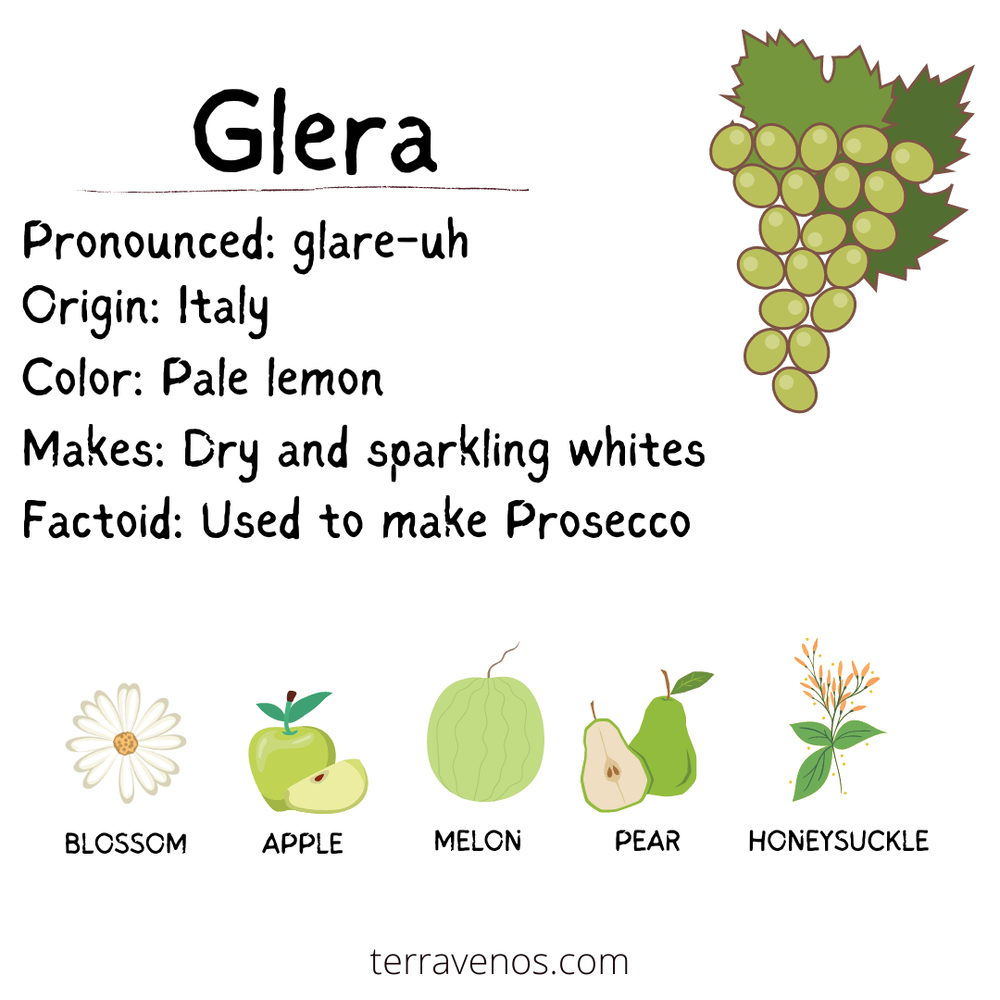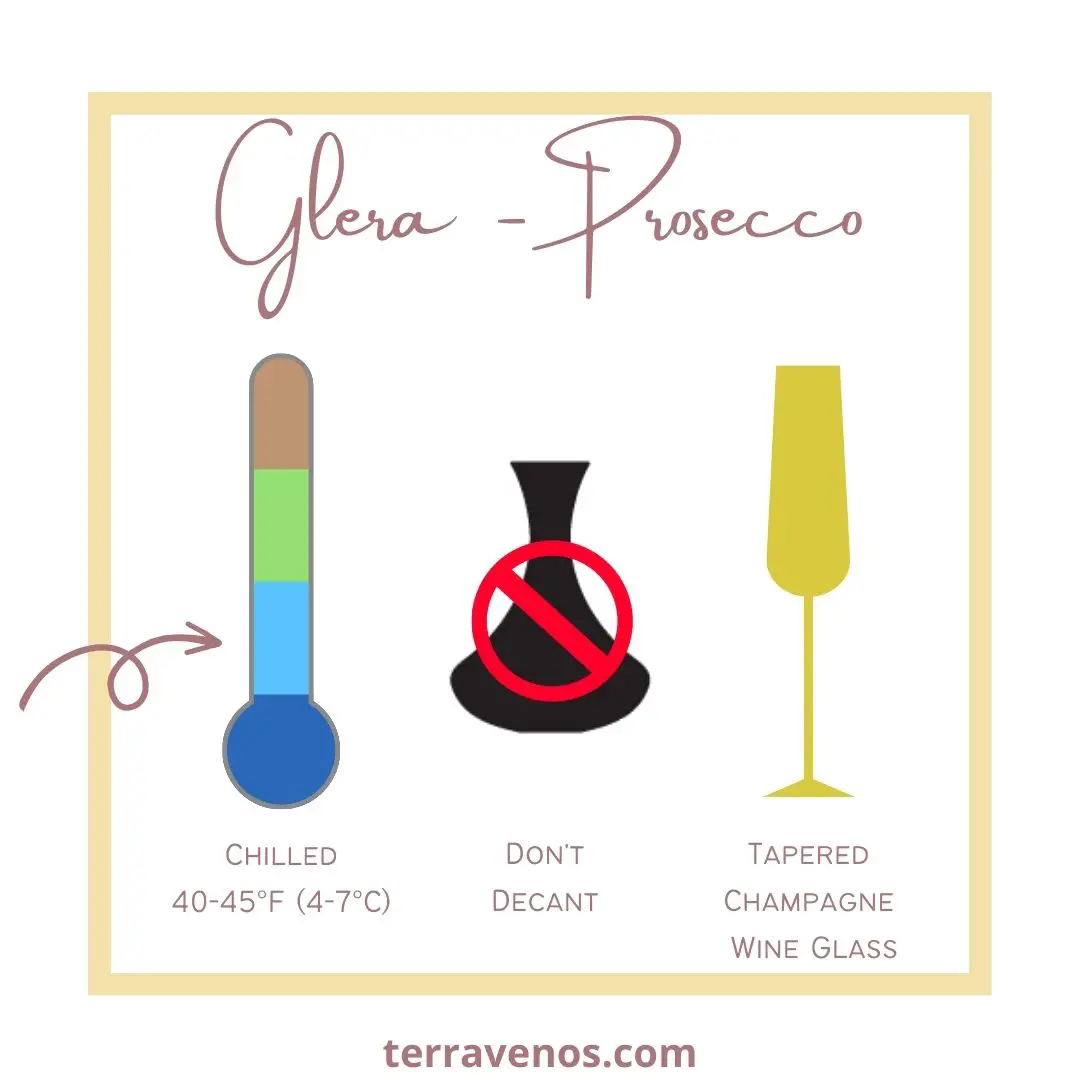
Pronunciation: GLARE-uh
Glera is a relatively neutral white wine grape from Italy, well-known for being the primary grape used to produce sparkling Prosecco. It creates a lively, effervescent wine with delicate stone, tree, and floral notes.
- What Kind of Wine Grape Is Glera?
- Is Glera the Same as Prosecco?
- Is Prosecco Always Glera?
- Where Does Glera Wine Come From?
- What Does Glera Smell Like?
- What Does Glera Taste Like?
- How to Serve Glera Wine as Prosecco
- Food Pairing Suggestions
- Notable Glera Producers and Bottles to Try
- Emerging Trends and Innovations
- Final Thoughts – Glera as Must-Try Sparkling Wine Varietal
What Kind of Wine Grape Is Glera?

Glera produces a light-bodied white wine with a moderate level of acidity. Glera’s a high-yielding wine grape and is usually grown in flat, fertile valleys. Higher fruit yields mean lower concentration of flavors and aromas. This can lead to less concentrated wines.
Is Glera the Same as Prosecco?
Glera is the main grape variety used to make Prosecco, but Prosecco is more than just Glera. To be labeled as Prosecco, the wine must come from specific regions in Italy, such as Veneto and Friuli Venezia Giulia, and follow certain production methods, including the Charmat method, which induces the wine’s sparkling character through a second fermentation in tanks. So, while Glera is a significant component of Prosecco, not all Glera wines can be called Prosecco.
Fun (and slightly confusing) Wine Fact: In a quirky twist, Prosecco’s name originally referred to the grape variety itself and other sparkling wine counterparts in Italy. However, to avoid confusion with the protected designation of origin, the grape was officially renamed Glera when seeking higher DOCG status in 2009, curbing others’ ability to label sparkling wines as “Prosecco” from different regions in the EU. This helped promote Italian Prosecco but caused much consternation from others making similarly styled wines using Glera outside of the region.
Is Prosecco Always Glera?
Yes, Prosecco is predominantly made from Glera grapes. By law, at least 85% of the wine must be Glera to be labeled as Prosecco. The remaining 15% can include other permitted grape varieties, such as Verdiso, Perera, Bianchetta Trevigiana, and Glera Lunga, which are often used to add complexity and enhance the overall flavor profile of Prosecco.
But Glera will always be the main grape in Prosecco.
Where Does Glera Wine Come From?
Glera’s heartland is in northeastern Italy, particularly in the Veneto region. These regions have a long history of growing Glera. Prosecco’s popularity has surged in recent years, making it one of the most beloved sparkling wines worldwide.
Check out this map of the historic home of Glera – see all those flat plains? Filled with Glera grape vines.
What Does Glera Smell Like?
Glera offers a fresh and fruity aroma profile with notes of green apple, pear, white peach, and citrus. These subtle fruit scents, along with floral hints, can create a delicate bouquet in your glass.
What Does Glera Taste Like?
Expect a light-bodied white wine with lighter flavors, featuring citrus and tree fruit. When made as a traditional Prosecco wine, you may get a dry or off-dry style, meaning there can be a kiss of sweetness.
Helpful Tip: Check out this post on Prosecco wines for a side-by-side comparison with Champagne.
How to Serve Glera Wine as Prosecco

Temperature
Serve your Prosecco chilled but not too cold, around 40-45°F (4-7°C). Never put sparkling wine in the freezer – lest you regret it.
Glassware
Choose a tall and narrow flute or tulip-shaped glass to enjoy Glera’s effervescence fully. The design of these glasses helps retain the bubbles and concentrate the wine’s aromas, enhancing your overall tasting experience.
Aging
Don’t age your Prosecco wines. They’re intended for youthful enjoyment on release. Can you keep them on your wine shelf or wine closet for a few years? Yes. But for most of us, you’re better off buying your Prosecco wines around the time that you want to enjoy them.
Food Pairing Suggestions

Glera’s light and fruity nature makes it an excellent match for different cuisines. Here are some pairing options to get you started:
- Prosciutto-wrapped melon bites (this is actually a personal favorite for sparkling wines)
- Bruschetta with tomatoes and basil
- Grilled shrimp with lemon and garlic
- Fresh fruit salad with a touch of mint
Personal Tip: For a refreshing twist, try adding a splash of elderflower liqueur to your Glera to create a delightful and slightly floral cocktail.
Helpful Tip: Still figuring out food and wine pairings? Here’s what you need to know about pairing flavors with different wines.
Notable Glera Producers and Bottles to Try

When you’re talking about buying Prosecco (and Glera), it’s usually seen as the thrifty alternative to Champagne or other traditional sparkling wines, but that doesn’t mean that there aren’t higher-quality producers.
Of course, if you’re just looking for a blending wine for your Sunday morning mimosas, then go for inexpensive bottles.
Here are some notable Prosecco producers that you should be able to find widely distributed:
- Valdo Spumanti: Known for crafting traditional Prosecco with a perfect balance of fruitiness and effervescence.
- Mionetto: A leading Prosecco producer with a wide range of expressions, from extra-dry to brut.
- La Marca: Offers high-quality Prosecco with a delicate and elegant flavor profile.
Emerging Trends and Innovations

The world of wine constantly evolves, and Prosecco made from Glera grapes is no exception. Current trends in the wine world include a love for all things pink, and today you can find sparkling rose Prosecco made from a blend of the white Glera grape and red Pinot Noir grape.
Be on the lookout for Prosecco Rose DOC
Final Thoughts – Glera as Must-Try Sparkling Wine Varietal
Glera, with its delightful fruity and floral characteristics, is an accessible sparkling wine option if you love bubbles. Whether you’re celebrating a special occasion or enjoying a casual get-together, Glera’s effervescence and approachable nature make worthy for your wine shelf.
Three key takeaways to remember about Glera:
- Subtle White: Glera offers a subtle profile of citrus, stone, and floral notes.
- Prosecco Workhorse: Glera’s the main grape used in Prosecco wine.
- Buy, Don’t Hold: Enjoy your wines made from Prosecco when you purchase them. These typically aren’t wines you’ll want to age for years. Save your cellar space for other ageable bottles.
Thirsty for More?
Here’s how to store your leftover sparkling wine.
Curious about how much sugar’s in Champagne? Check out this post.
Everyone wants to do it, but it’s actually kind of hard. Here’s a guide to pairing Champagne and chocolate.




